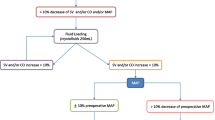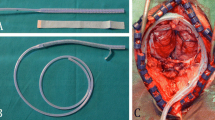Abstract
Background
To assess the efficacy of equimolar mixture of nitrous oxide/oxygen (EMNO) to prevent pain induced by venous access ports (VAPs) implantation in cancer patients.
Patients and methods
In a randomized, double-blind study on an adult population not knowing the effects of EMNO, cancer patients were randomly assigned to breath via a facial mask, EMNO or a placebo mixture comprising 50% oxygen and 50% nitrogen. The primary end-point was the patients’ assessment of the severity of pain evaluated using a visual analog scale (VAS, 0 to 100) and the proportion of patients suffering pain in each group. The secondary criteria were side effects, tolerability of EMNO, and the level of satisfaction of both the patients and the medical team.
Results
Eighty-three adults (42 in the EMNO group and 41 in the placebo group) were included. VAPs were implanted in the jugular vein in 95% of patients. In the placebo group, 78% of the patients declared that they found VAP implantation painful vs. 34% in the EMNO group (p=0.001). The severity of the pain was reduced by 50% in the EMNO group in comparison with placebo (p=0.0125). Although the median time to perform implantation was strictly identical in both groups (20 min), the estimated duration of surgery seemed longer to patients in the control group. Patient and investigator satisfaction indexes were >90% in both groups.
Conclusion
EMNO provides an effective solution for the prevention of pain during placement of VAPs.
Similar content being viewed by others
Notes
In the EMNO group, one patient was unable to evaluate his pain with the VAS.
References
Annequin D, Carbajal R, Chauvin P, Gall O, Tourniaire B, Murat I (2000) Fixed 50% nitrous oxygen mixture for painful procedures: a French survey. Pediatrics 105:1–6
Berkowitz B, Finck A, Ngai S (1976) Nitrous oxide “analgesia”:resemblance to opioid action. Science 194:967–968
Berkowitz B, Finck A, Ngai S (1977) Nitrous oxide “analgesia”:reversal by naloxone and development of tolerance. J Pharmacol Exp Ther 203:539–547
Evans J, Buckley S, Alexander H, Gilpin A (1995) Analgesia for reduction of fractures in children: a comparison of nitrous oxide with intramuscular sedation. J Pediatr Orthop 15:73–77
Fauroux B, Onody P, Tourniaire B, Gall O, Clément A (2001) Nitrous oxide improves the comfort and the tolerance of fiberoptic bronchoscopy in children. Eur Respir J 18:190S
Flomenbaum N, Gallagher E, Eagen K, Jacobson S (1979) Self-administered nitrous oxide:an adjunct analgesic. JACEP 8:95–97
Gall O, Annequin D, Benoit G, Glabeke E, Vrancea F, Murat I (2001) Adverse events of premixed nitrous oxide and oxygen for procedural sedation in children. Lancet 358:1514–1515
Gillman M, Lichtigfeld F (1994) Opioid properties of psychotropic analgesic nitrous oxide (laughing gas). Perspect Biol Med 38:125–138
Gillman M, Lichtigfeld F (1980) Paradoxical effect of naloxone on nitrous oxide analgesia in man. Eur J Pharmacol 61:175–177
Hennequin M, Faulks D (2001) Indications de sédation par inhalation d’un mélange équimolaire d’oxygène et de protoxyde d’azote en odontologie. Entretiens de Bichat, E. S. F. 2001. Paris
Jevtovic-Todorovic V, Todorovic S, Mennerick S, Powell S, Dikranian K, Benshoff N, Zorumski C, Olney J (1998) Nitrous oxide (laughing gas) is an NMDA antagonists, neuroprotectant and neurotoxin. Nat Med 4:460–463
Kaufman E, Chastain D, Gaughan A, Gracely R (1992) Staircase assessment of the magnitude and time course of 50% nitrous-oxide analgesia. J Dent Res 71:1598–1603
Luhmann J, Kennedy R, Porter F, Miller J, Jaffe D (2001) A randomized clinical trial of continuous flow nitrous oxide and midazolam for sedation of young children during laceration repair. Ann Emerg Med 37:20–27
Maze M, Fuginaga M (2000) Recent advances in understanding the actions and toxicity of nitrous oxide. Anaesthesia 55:311–314
Roberts G, Wignall B (1982) Efficacy of the laryngeal reflex during oxygen-nitrous oxide sedation. Br J Anaesth 54:1277–1281
Vetter T (1995) A comparison of EMLA versus nitrous oxide for pediatric venous canulation. J Clin Anesth 7:486–490
Acknowledgements
This project was supported by grants from the PHRC (Programme Hospitalier de Recherche Clinique), Marc Lemaire, M.D., Air Liquide Santé, International.
Author information
Authors and Affiliations
Corresponding author
Rights and permissions
About this article
Cite this article
Douard, M.C., di Palma, M., d’Agostino, P. et al. Prospective, double-blind, randomized trial of equimolar mixture of nitrous oxide/oxygen to prevent pain induced by insertion of venous access ports in cancer patients. Support Care Cancer 14, 161–166 (2006). https://doi.org/10.1007/s00520-005-0852-1
Received:
Accepted:
Published:
Issue Date:
DOI: https://doi.org/10.1007/s00520-005-0852-1




